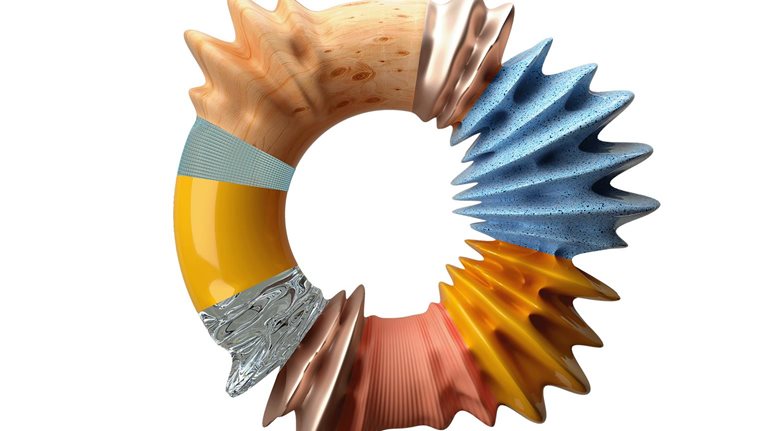In the past year, the materials industry has once again seen several shifts: increasing resource nationalism and protectionism, the rise of new demand vectors from AI and defense, emerging signs of a productive rebound, and the slowdown of decarbonization in selected regions.
Overall, the materials industry contracted in 2024, with metals and mining revenues down 6 percent to approximately $3 trillion, partially offset by growth in other materials sectors, while profitability remained resilient at about $1.3 trillion (with metals and mining accounting for $700 billion), coming with a shift in profit pools from thermal coal and steel toward gold, copper, and aluminum, a shift that has been ongoing for several years.
Geopolitical focus on materials has intensified, with new tariffs, incentives, and export barriers,1 while supply concentration continued to rise for several commodities in both mining and refining. Our analysis shows that measures primarily focus on commodities that appear on countries’ critical minerals lists and have high supply concentration (except for US tariffs).
Meanwhile, decarbonization progress has slowed in some regions. In Europe and the United States, for example, battery-electric-vehicle (BEV) sales as share of total car sales flattened or slowed compared with previous years. At the same time, bold innovation in technology, processes, and electrification has accelerated.
Against this backdrop, capital markets have remained strong, with total shareholder returns (TSR) growing 3.5 times and market capitalization doubling since 2015.
In summary, the materials industry has seen four significant shifts since last year’s report:
- Geopolitics and a global landscape where globalization is changing but not disappearing have led to increased resource nationalism or protectionism.2 This has created additional risks, such as inaccessible end markets and the need for local supply integration, as well as opportunities, such as financial incentives for new projects in resource-importing regions.
- Accelerated demand from the expansion of AI technologies will likely have a material impact on demand profiles, especially for copper—for example, projections show an increase in copper demand related to data centers of 3 percent by 2030, partially offsetting slowdown in demand from lower-carbon technologies.
- A recent capital intensity and productivity rebound is becoming visible in the mining industry—and several new technologies and practices have emerged that hold promise for continuing this trend, including generative AI.
- Decarbonization is slowing in selected regions and commodities, most notably in the European steel industry, in which nearly a third of announced projects have been put on hold or canceled. At the same time, thermal coal demand has continued to increase, with record production of eight gigatons (Gt).
Looking ahead, the demand outlook through 2035 appears robust across all scenarios. Primary drivers of this growth include population growth and the development of the middle class as well as the deployment of low-carbon technologies—with energy transition materials driving more than half of growth. In addition, demand growth could come from new applications, such as AI data centers, as well as potential additional upside from the defense sector. Together, China and the rest of Asia could account for more than 45 percent of this growth.
On the supply side, capacity ramp-up has kept pace with forecasts, with Chinese firms continuing to grow their market share outside of China. However, supply remains highly concentrated, and several key commodities (such as REEs) face persistent constraints. Although the global supply–demand gap is narrowing, closing it completely could require trillions of dollars in investment, massive new power capacity, and continued innovation.
In this context, we see three areas of opportunity:
- Pursue growth in the multilateral world by expanding into new geographies and critical materials—where you have a clear “right to play” with possible tailwinds from government incentives—or unlocking value from scrap, recycling, and niche high-growth sectors and products related to digital infrastructure and defense.
- Accelerate the productivity “rebound” through gen AI, automation, next-generation operational excellence, and global sourcing to counter productivity declines and rising costs from lower ore grades; labor shortages; environment, health, and safety requirements; and project complexity.
- Pursue targeted sustainability efforts by advancing decarbonization with stepwise, cost-effective approaches that cut emissions while scaling low-carbon processes, recycling, and circular business models—but don’t anchor business cases in green premiums (for now).
As 30 to 50 percent of TSR overperformance is driven by company operating decisions, top-quartile productivity and disciplined growth remain the clearest markers of long-term success, reflected in stronger margins, resilient returns, and lasting competitiveness. Although challenges ranging from tighter supply–demand balances to stricter decarbonization targets loom, bold innovators are already reshaping the competitive landscape.
MineSpans market intelligence services
Offer a comprehensive outlook of the metals and mining industries. Built by McKinsey’s commodities experts, and covering more than 14,000 global assets across more than 15 commodity value chains, our detailed bottom-up supply and demand forecasts, granular cost models, and ESG data empower decision makers.
Our Global Materials Perspective 2025 provides a systemwide view of these shifts, spanning mines, manufacturing, infrastructure, consumer markets, and finance. Looking ahead, success in metals and mining will likely require not only capturing growth but also improving productivity and delivering sustainable solutions. Those willing to act decisively will be best positioned to seize the opportunities ahead.
Following a period of high price volatility driven by increased supply chain disruption and volatility in energy prices, among other factors, materials revenues slightly contracted in 2024 to about $6.7 trillion.
A cyclical reset in metals and mining, which contracted by 6 percent to approximately $3 trillion, was almost fully offset by growth in other subsectors. The decline was primarily the result of price adjustments in thermal coal, steel, and battery materials.
Nevertheless, 2024 ranks among the sector’s four highest-earning years in the past two decades.

Some countries are taking actions to preserve their preeminent positions in the global supply landscape or improve local value addition by implementing export barriers or enforce local downstream integration. Recent years in particular have seen a trend of African nations imposing export barriers on ore and concentrates to stimulate local downstream processing.
At the same time, countries that are not self-sufficient are increasing efforts to stimulate local development through import barriers, resource development funds, and the announcement of strategic projects that have better access to funding and accelerated permitting. In addition, there is a trend toward stockpiling to mitigate economic effects of (temporary) disruptions to global supply chains.

Although projected demand growth until 2035 for several commodities (notably steel, copper, and aluminum) decreased compared with last year’s report, overall materials demand remains resilient (except for metallurgical coal, iron ore, and PGMs).
Energy transition materials show strong momentum, with a projected CAGR of 4.5 percent through 2035. However, this momentum has been tempered by a slowdown in decarbonization efforts in some regions, leading to downward pressure on battery materials and REEs, alongside broader economic headwinds.
Looking ahead, defense and data centers are likely to be key sectors to drive increased material demand in the coming years.

Looking at the project pipeline, the next decade promises growth opportunities across regions for many commodities.
There are some signs of large-scale diversification, with changes in the top three supplying countries for more than half of the world’s largest commodities (based on revenue). With up to 60 percent of global reserves located outside the top three supply countries—including 62 percent of copper, 44 percent of REEs, and 36 percent of lithium—significant opportunities for future reserve development are likely to emerge beyond today’s announced projects.

In 2024, forecast supply–demand balances for nickel and cobalt shifted from projected shortages to possible surpluses.
Today, a similar trend is emerging in the high-case supply scenario for several other commodities, including uranium, REEs, and manganese. For instance, the moderation of EV adoption led to decreased demand for REEs. Meanwhile, China’s construction slowdown reduced demand for steel and, consequently, demand for metallurgical coal and manganese.
Supply–demand imbalances are still expected for most commodities, especially in a base-case supply scenario and for four commodities in a high-case supply scenario (metallurgical coal, silver, REEs, and manganese).

The commodity supercycle from the early 2000s to early 2010s was marked by massive investment and rising costs. Yet this period delivered only limited production growth, leading to a sharp decline in productivity.
As commodity prices declined in the first half of the 2010s, mining companies shifted focus toward operational efficiency, primarily targeting labor productivity to offset persistent cost inflation, which put downward pressure on capital productivity in particular.
The industry entered a recovery phase around 2018, though the COVID-19 pandemic temporarily interrupted progress. Notably, gains have extended beyond labor to include improvements in capital and productivity in factor cost, supported by the accelerated adoption of automation and digital technologies.

Incentive prices for copper, nickel, and lithium remain above current market levels to meet projected 2035 demand, leaving many new projects uneconomic at today’s prices. Improving productivity, substituting commodities, or, in the longer term, exploring new projects are alternative pathways to resolve these higher incentive prices.

Next-generation technologies and operational excellence are creating new opportunities to increase productivity across the value chain:
- Traditional AI models continue to progress as access to low-cost computing power increases. For example, the technology can cut fleet fuel consumption by up to 10 percent by connecting fleet management, enterprise asset management, machine Internet of Things, and other operational data (such as tire pressure, road layout, and quality sensors).
- Gen AI use cases are becoming increasingly tailored to the materials industry, such as through real-time assistance in reactive-maintenance procedures.
- Automation is becoming more attractive as labor becomes scarcer, especially in remote locations—for example, by implementing autonomous haul trucks.
- Electrification is advancing rapidly across several use cases—for example, the use of electric haul trucks or scale-up of (thermal) storage solutions.
- Global supplier diversification is creating opportunities as the continued innovation of nonincumbent players increases the landscape of technical and cost-competitive industrial equipment.
Together, these levers can help offset rising costs, improve productivity, and enhance long-term competitiveness.

Compared with 2024’s survey of decision-makers in materials sales and purchases, there is an overall slowdown in willingness to pay premiums for green materials, with more customers preferring no or limited premiums. Aluminum remained relatively stable, with approximately 50 percent of customers unwilling to pay, while steel and copper increased from approximately 35 and 40 percent to around 50 percent.
The variation in willingness to pay premiums highlights the importance of customer segmentation in go-to-market approaches for sustainable materials. On this point, targeting the right customer segment with a win–win value proposition can improve the economics of decarbonization business cases.

Of all DRI projects planned in the European Union as of Q4 2024, approximately 40 percent (with a total capacity of 14 metric megatons per annum) are now on hold or canceled.
At the same time, nearly 30 percent of the low-carbon steelmaking initiatives in Europe face delays or suspension.
Both points highlight the growing challenges in advancing the EU’s decarbonization efforts for steel, not in the least driven by low margins in the sector.

Over the next decade, total metals and mining emissions could decrease by a modest 6 percent. By 2035, demand growth is expected to add roughly 620 metric megatons of CO2 equivalent per year, driven largely by the expansion of battery-material production. This increase is projected to be offset by grid decarbonization (responsible for about 40 percent of the emissions decline), efficiency improvements (30 percent), and greater use of recycled materials (20 percent), resulting in an overall net reduction in emissions.

To request access to the data and analytics related to our Global Materials Perspective, or to speak to our team, please contact us.



